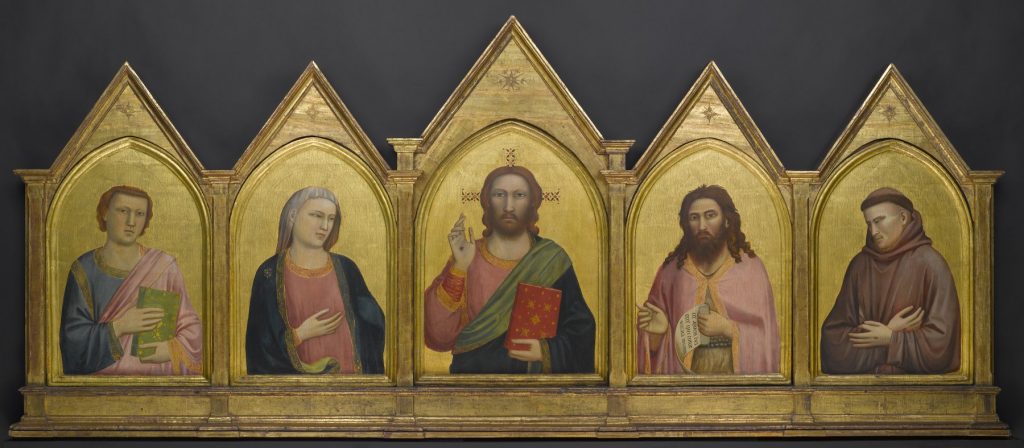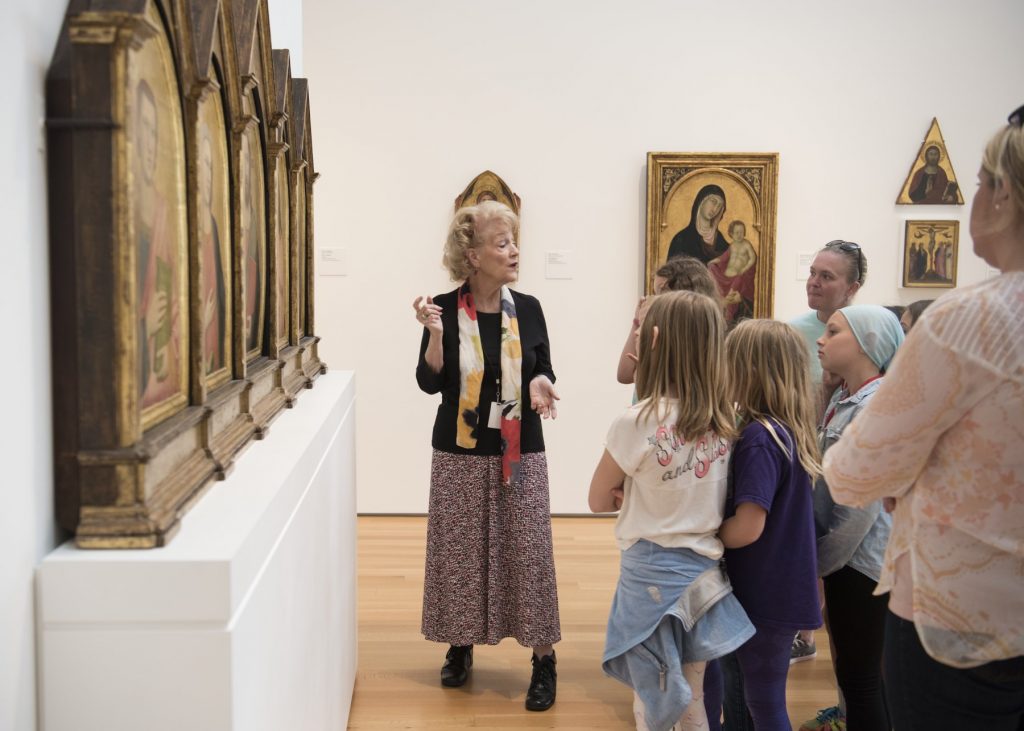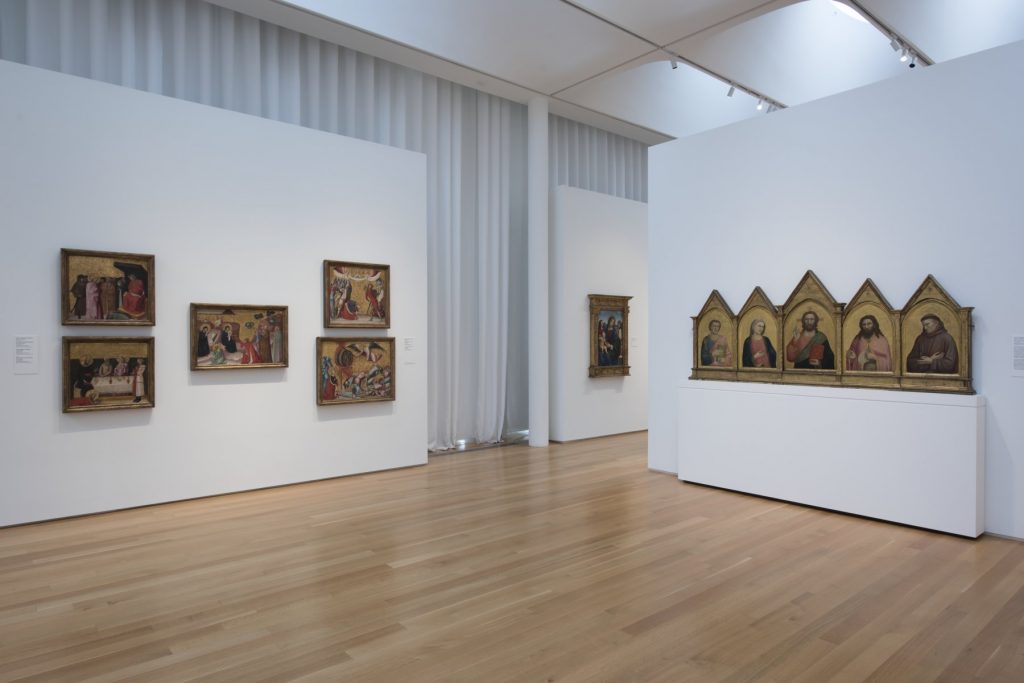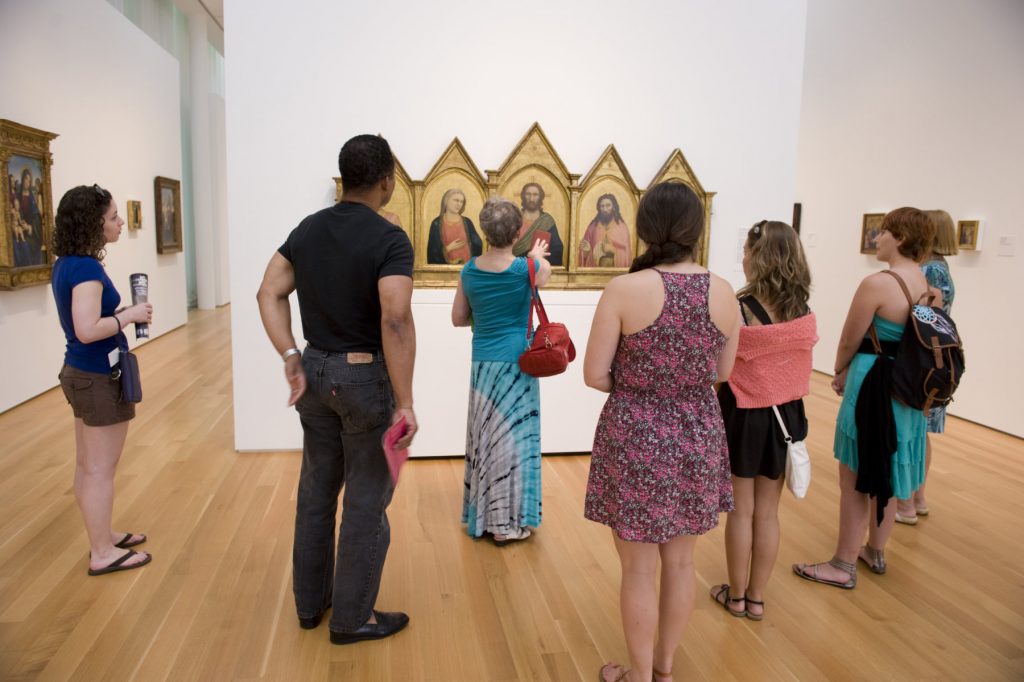Christ Blessing with St. John the Evangelist, the Virgin Mary, St. John the Baptist, and St. Francis (known as the Peruzzi Altarpiece) (work of art)
Artwork Info
Key Ideas
- This is an altarpiece, or a work of art that decorates the space above and behind the altar in a church.
- This five-panel altarpiece is three feet tall and eight feet wide. It is called a polyptych (pol-ip-tik), which means it is a painting with more than three panels.
- It is known as the Peruzzi Altarpiece because it was commissioned by the Peruzzi family. This wealthy family owned a banking empire throughout Europe. The altarpiece was made for their private chapel in the Church of Santa Croce. It would have served as a backdrop for the Peruzzi family’s celebration of the Holy Mass.
- Giotto di Bondone (known as Giotto) was the most famous artist of his time in Florence, Italy. He is considered to be the father of the Italian Renaissance. He is best known for painting lifelike, natural-looking figures.
- Giotto used vermilion (a bright red pigment) in this painting to communicate the religious importance and status of Jesus and the Bible.
- The process of creating vermilion was a major scientific achievement.
Learn More
Giotto di Bondone was a painter, sculptor, and architect from Florence, Italy. Known as Giotto, he was the most famous artist of his time. By the time he created this altarpiece (around 1310), his paintings were known throughout Italy. Poets and writers from the 14th and 15th centuries praised Giotto’s ability to paint realistic-looking human figures. The gestures and facial expressions of the figures in his paintings look natural and lifelike. Generations of art historians have credited Giotto with sparking the artistic revolution known as the Renaissance. He is often referred to as the father of the Italian Renaissance.
The center panel of this polyptych (five-panel painting) depicts Jesus Christ giving his blessing. The female figure to his left is the Virgin Mary, and to her left is St. John the Evangelist. To the right of Jesus are St. John the Baptist and St. Francis. The imagery of these saints suggests that the altarpiece was commissioned by the Peruzzi family, for their private chapel in the Franciscan Church of Santa Croce in Florence. The saints depicted in this painting were especially important to this specific church. The Peruzzi Altarpiece is one of the few complete, surviving altarpieces by Giotto. It is the only one preserved outside of Europe.
The Peruzzi family is among a small number of elite families who paid for the rights to establish an altar in the front of the church. It was considered a privilege and a sign of high status to have a private seat in the front of the church next to the high altar. Wealthy families competed with each other to commission the most luxurious decorations for their private seating areas. They commissioned well-known artists to create frescoes, altarpieces, and stained-glass works for their chapel spaces.
Giotto used vermilion on this altarpiece to communicate the religious importance and status of Jesus and the Bible. Vermilion is a bright red, fade-resistant pigment. It is chemically identical to cinnabar, which is a natural mineral. Cinnabar was used as a red pigment for at least 1,000 years before vermilion was invented.
Vermilion was made through alchemy, a combination of early science and spiritual beliefs. The creation of vermilion seemed miraculous to many people. The process of making vermilion is considered to be a major achievement in technology and chemistry. It involved mixing pure yellow sulfur with silver mercury, which produced a dark, almost black substance. When the black material was ground into a powder, it gradually turned red. A longer grinding process resulted in an even brighter red red pigment.
The mercury content in vermilion makes it highly toxic. Many artists were alchemists (and may have made vermilion themselves), but the process of making it was dangerous. Poorly paid servants or assistants were often given the task of processing the raw materials into vermilion.
Additional Resources
Resources for Teachers
- Learn more about Giotto and his work.
- Listen to an audio description of the Peruzzi Altarpiece.
- Watch a short documentary about the artist’s life and art.
Resources for Students
- Experiment with making a portrait of a person, using Giotto’s work as inspiration.
- Take an interactive tour of the Peruzzi Altarpiece at the Getty Museum.
- Watch a video that explores another example of this artist’s work and learn about his influence on early Renaissance naturalism.




